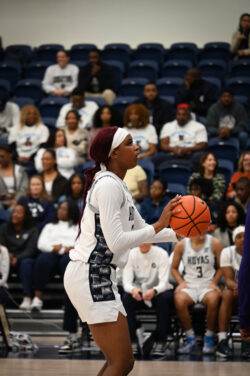“This place should have a good football program,” says Georgetown Head Coach Rob Sgarlata in his office while preparing for his team’s Tuesday morning practice. “We’re excellent at everything that we do. This whole place is built on being the best you can be at what you’re doing. There’s no reason why this football program shouldn’t be the same thing.”
To say that the Georgetown football team has struggled for much of the past decade would be an understatement. Since joining the Patriot League in 2001, the Hoyas have had only one winning season and play their home games in the smallest stadium in all of Division I football: Multi-Sport Field, an unfinished stadium that has seen numerous setbacks in funding and university prioritization since the Hoyas started playing there in 2005.
And it’s only gotten more difficult for the program. In 2012, the Patriot League allowed its football members to start offering athletic scholarships beginning with the freshman class entering in fall 2013. Georgetown was the only school that chose not to offer scholarships, instead opting to continue utilizing the need-based financial aid model used by Ivy League programs.
No one is as familiar with these challenges that the program faces as Sgarlata. He graduated from Georgetown in 1994 as one of the football program’s all-time leading rushers and spent 18 years as an assistant coach on the Hilltop before assuming the head coaching role in February 2014.
“I knew the score when I took this job,” Sgarlata says as he leans down to put on his running sneakers before practice. “I don’t waste my time thinking about scholarships. The Patriot League is where we should be.”
He then grabs an investment banking-style pitchbook detailed with charts, statistics, and maps on how the Hoyas recruit, emphasizing what he’s dubbed as his staff’s “hit’em where they ain’t” strategy.
“Can we beat a lot of the scholarships in the Northeast at times for those who would pay $60,000 to go here versus nothing to go to Lehigh, Colgate, and Lafayette? No,” Sgarlata says. “That’s why we’re in Florida, Texas, Georgia, Nevada, Washington, and Louisiana. I need to get 16 to 20 kids next year. If I can’t do that with nine coaches recruiting nationally with Georgetown’s brand and find kids of the same caliber that everybody else is getting in the Northeast, then we have a problem.”
That’s why he sees his coaching staff as especially key. In his first year, all of Sgarlata’s personnel consisted of people he had either played or coached with before. He wanted people who knew how to recruit at Georgetown, who knew the type of athlete they were looking for.
“We want tough kids who play two sports. We want weight-room guys. We want kids that, no matter their background, understand what it is to really work at it.”
But before heading out to practice, Sgarlata emphasizes that he and his staff have one goal each day.
“Our number one goal is to make sure our players are taken care of,” Sgarlata said. “The players are recruited here and are coming here for a vision and for things that we’re telling them are going to happen. Our job is to make sure those things happen to the best of our ability.”
The vision for the program is on full display behind Sgarlata as he speaks, where a crest is adorned with the three tenets of the program: “four for 40,” “men for others” and “Sisu.”
“Four for 40” reflects that a commitment to Georgetown is not just a four year commitment to football, but a forty year relationship that builds personal, professional, and career leadership throughout one’s life. “Men for others,” represented by a sun on the crest, symbolizes the team’s commitment to living up to the Jesuit values of service to the wider community. Lastly, “Sisu,” a Finnish word that does not directly translate to English, expresses the will to fight and prevail even against the most insurmountable of odds. It stems from former Georgetown defensive end Janne Kouri (B’97), whom Sgarlata has a close relationship with, and his efforts to battle back from paralysis and how he is a living embodiment of that ideal.
For Sgarlata, who enters his second year at the helm of the Hoya football team, these distinct ideals display the type of program he wants to build and the type of people that he believes his players should aspire to become, no matter their obstacles.
***
That commitment to putting the players first starts right at the top with Sgarlata, as the door to his office inside McDonough Arena has a sign that reads “This meeting may be interrupted at any time by a Hoya Football Player.” It’s one of the many actions that Sgarlata and his staff have taken to build a culture where players see their coaches and fellow teammates as not just part of a team, but part of a family.
“Coach Sgarlata is a player’s guy,” senior running back Jo’el Kimpela says. “He’s really invested in our lives outside of football. We’ve gotten close to the other coaching staff. That player and coach interaction, I think that’s something that’s changing and is going to continue.”
It’s a drastic shift from the regimented style of previous Head Coach Kevin Kelly, especially for senior defensive back Ettian Scott.
“I don’t even know if he knew my last name. That’s a big difference,” Scott says.
As a result of this renewed focus on the individual players, Sgarlata, more affectionately known as “Coach Sgar” to his players, has created an all hands on deck, bottom-up approach that has many players feeling their voices are heard.
“I feel the vision. I’m part of the vision. We’re striving for a goal not just on the field, but off the field,” said senior defensive lineman Dez Richardson. “The coaches are more active. The coaches are all on board. The players are all on board. Coach Sgar really came to instill some values in this football program.”
Those core values of “four for 40”, “men for others” and “Sisu” have certainly paid dividends, according to Kimpela.
“We all come from different places, different races, and different economic backgrounds. But when we come together and put those pads on, I feel like we’re just one team. There’s not one individual. It’s a family.”
Sgarlata does not want to create a family atmosphere solely among the team, he wants to extend it to the wider Georgetown community. Several initiatives undertaken include “4 for 40” Fridays, where alumni return to offer career advice on the Friday before each home game, and the Faculty Fellows Game, where players recommend two to three faculty or staff members to be invited to a home game.
“One of the most exciting things about this place is that there’s not one person on campus who I’ve asked for help that hasn’t helped us,” Sgarlata said. “The support we get is unbelievable. I haven’t been refused yet. That’s not because of me, it’s because of our kids. If they didn’t do a good job, they wouldn’t offer help.”
The focus by Sgarlata and his coaching staff on having the Hoyas be successful in the classroom has certainly paid off. Last season, 45 Hoyas were named to the Patriot League Academic Honor Roll, which requires a player to earn a 3.2 grade point average or higher during the semester of their respective sport. The number set not only a program record but a league record as well.
***
And while success off the field has certainly come to fruition, the team feels it has been making strides on the field as well, where the Hoyas will look to defy their last place pegging in the Patriot League Preseason Poll.
“We’ve been putting in the work and we will continue to put in the work,” said Richardson. “When next Saturday comes, all we have to do is show everyone that us being picked to finish 7th in the Patriot League is just crap.”
The intensity level of practice did not fit one of a last place team. Players and coaches alike demand accountability and attention to detail from each other. Sgarlata himself paces from drill to drill, hopping in to demonstrate the proper technique of running a fade route to the receivers to showing defensive players where to position themselves against a specific offensive formation. It’s the little things that count.
But that’s not exclusive to on-field preparation for Sgarlata, his staff, and his players. A post-lunch meeting with Special Teams Coordinator Kevin Doherty runs through a chart of at least 40 unique in-game situations and how the Hoyas will approach them such as a fake field goal attempt. A film session among the team’s offensive staff ends with a discussion on how to rename a play call because it currently sounds too similar to the name of another set. And the offensive team’s film session, spoken in jargon that even the most devoted of football fans would only partially understand, sees players quizzed by Offensive Coordinator Michael Neuberger on the notes that they’re jotting down.
Yet, Sgarlata and his staff aren’t afraid to ask for help. In fact, they welcome it, as Sgarlata has brought in numerous speakers over the past two seasons to speak to his team. Notable names include former NFL Commissioner and Vice Chair of the University’s Board of Directors Paul Tagliabue, and former U.S. Secretary of Transportation Rodney Slater.
“It’s kind of like how you hear your dad say something 50 times and then you hear your uncle say it once,” Sgarlata said. “They’re preaching the same things as our coaching staff but it just gives our players another perspective.”
***
After almost three weeks of their rigorous training camp schedule, which has the team hard at work from seven in the morning to nine at night, the Hoyas are confident heading into their season opener against St. Francis (PA) on September 5. Making the short walk with the team from McDonough to Reynolds for a team meeting after dinner, one can hear players talking about how they’re going to surprise all their naysayers this season.
But while seniors such as Richardson know that they may not see immediate results on the field, they believe they’re building the foundation of a culture that will lift the program out of mediocrity and to new heights.
“We’re in the process of becoming something great. I may not see it. We may not see it. But we’ll get there.”





